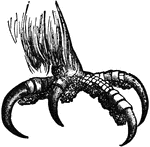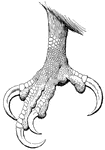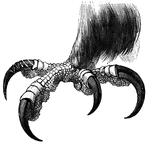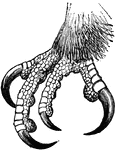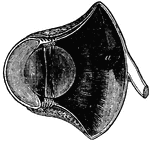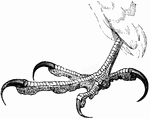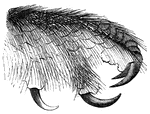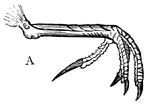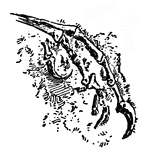The Bird Anatomy ClipArt gallery offers 411 illustrations of skeleton diagrams, arteries, digestive system, eggs, feathers, and both internal and external diagrams.
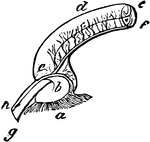
Eagle's Ampulal
"Part of the superior vertical semicircular canal, showing its ampulla (which is the dilatation of the…

The Inner Ear of an Eagle
"Membranous labyrinth of Haliaetus albicilla (White-tailed Eagle), X2. a,b, cochlea; b, its saccular…

Bill of Eagle
"The beak or bill of birds is composed of two bony pieces, called mandibles, surrounded by a horny substance,…
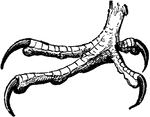
Foot of White-Headed Eagle
"In birds of prey the claws are powerful and hooked; in others the foot is flat, claws straight, and…

Wing of an Eagle
"The more angular the wing of birds - that is to say, the longer the feathers on the edge of the wing…

Egg
A body formed in the females of birds, and some other animals, from which their young is produced.

Egg Parts
"Section of a Hen's Egg before Incubation. a, yolk, showing concentric layers; a', its semi-fluid center;…

The Bill of an Eider
"Somateri mollissima. Somateri dresseri. Common Eider. Bill gibbous at base of upper mandible; outline…
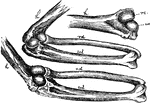
Mechanism of the Elbow-Joint
"Fig. 28. - Mechanism of elbow-joint. ..., where rc and uc show respectively the size, shape, and position…

Embryo Chick
Embryo chick (36 hours), viewed from beneath as a transparent object (magnified). Labels:pl, outline…
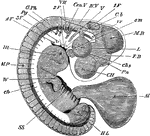
Embryo Chick at Fourth Day
Embryo chick at fourth day, viewed as a transparent object, lying on its left side. CH, cerebral hemispheres;…

Cells of an Embryo Chick
A transverse section through an embryo chick (26 hours). Labels: a, epiblast; b, mesoblast; c, hypoblast;…

Transverse Section of an Embryo Chick
Transverse section of an embryo chick (third day). Labels: mr, rudimentary spinal cord; the primitive…

Right Eyeball of Bird
"Right Eyeball of Bird, seen from behind, showing the following muscles; a, rectus superior; b, rectus…

Falcon
"A falcon. mn., Mandible; C., cere; N., nostril; E.C., ear covert; th.W., thumb wing; C., wing coverts;…
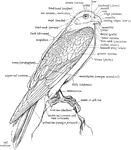
A Labeled Diagram of a Falcon to Show the Nomenclature of the External Parts
"The annexed figure explains the nomenclature of most of the outward of a Bird, but some further explanations…

The Skeleton of the Trunk of a Falcon
"Skeleton of the trunk of a Falcon. Ca, coracoid, which articulates with the sternum (St) at ; Cr, keel…

Feather
One of the growths, generally formed each of a central quill and a vane on each side of it, which make…
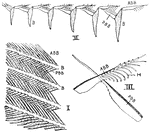
Feather Parts
"Parts of a feather. I., Four barbs (B.) bearing anterior barbules (A.BB.) and posterior barbules (P.BB.);…
Feather Shaft
"The feathers are horny productions, consisting of a hollow tube or barrel and a stem rising from it."

Structure of a Feather
"Fig. - 20 - Two barbs, a, a, of a vane, bearing anterior, b, b, and posterior, c, barbules; enlarged;…

Feather Tube
"The feathers are horny productions, consisting of a hollow tube or barrel and a stem rising from it."

Feather Types
"Types of feathers. D., Down. 2, Developing feather in sheath (sh.). 3, Covert of heron showing aftershaft…
Feather Web
"The feathers are horny productions, consisting of a hollow tube or barrel and a stem rising from it.…
Feathers
"A., Filoplume. B., very young feather within its sheath (sh.); c., the core of dermis; b., the barbs.…
Filoplume of a Goose
"Filoplume. In ornithology, a thread-feather; a thread-like or hair-like feather, with a very slender…

The Bill of a Purple Finch
"Carpodacus. Purple Bullfinch. Bill smaller and less turgid than in Pinicol or Pyrrhula, more regularly…

Meadow Lark Foot and Bill
"Sturnella magna. Field Lark. Old-field Lark. Meadow Lark. The colors, as above described, rich and…
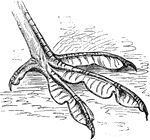
Coot Foot
"Fig. 53 shows the lobate foot of a coot. In the lobate foot, a paddle results not from connecting webs,…

Grackle Foot
"Quiscalus. Grackle. The feet are large and strong, and the birds spend much of their time on the ground,…
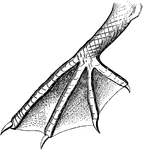
Pelican Foot
"Fig. 52 shows the totipalmate foot of a pelican. The totipalmate is a special case of palmation, in…

Phalarope Foot
"Fig. 53 bis - shows the lobate foot of a phalarope. In the lobate foot, a paddle results not from connecting…

Fin-Footed Coot Foot
"In ornithology, pinnatiped; having pinnate feet, the toes being separately furnished with flaps, as…
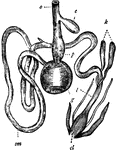
Fowl Digestive System
"Digestive system of the common Fowl. o, Gullet; c, Crop; p, Proventriculus; g, Gizzard; sm, Small intestine;…

The Ear Bone of Fowl
"Mature stapes of fowl, about x4; after Parker. st, its foot, fitting fenestra ovalis; mst, main shaft,…
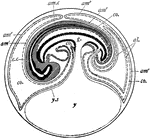
Fowl Embryo
"Diagram of a longitudinal section through the embryo of a fowl, showing formation of amnion and allantois…

Fowl Skull
The skull of an adult fowl. Here the temporal fossa is bridged over by the junction of the post-frontal…

Skull of a Common Fowl
"Fig. 62 Skull of common fowl, enlarged. from nature by Dr. R.W. Shufeldt, U.S.A. The names of bones…

Common Fowl Skull
"Schizognathous skull of common fowl, nat. size, from nature, by Dr. R.W. Shufeldt, U.S.A. Letters as…
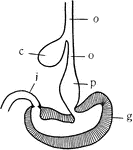
Fowl Stomach
"Diagram of the stomach and esophagus of the fowl. o, esophagus; c, crop; p, proventriculus or glandular…
